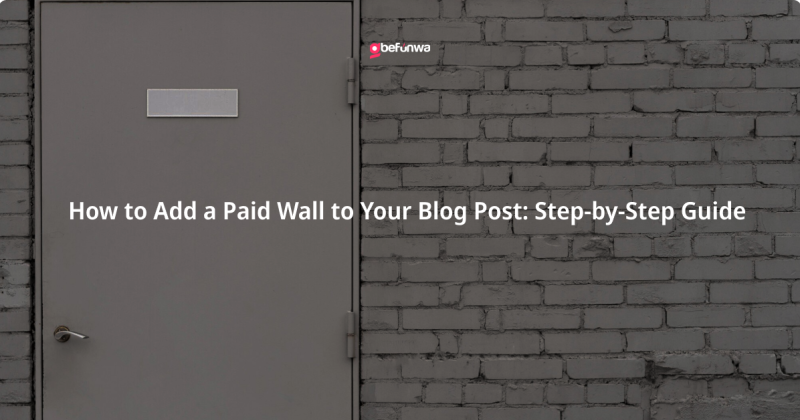
In the current age, it makes sense for website owners to seek innovative ways to monetize their work. One popular method is implementing a paid wall, where readers must pay a fee to access premium content. This strategy not only generates revenue but also incentivizes quality content creation. If you’re looking to add a paid wall to your blog posts, here’s a detailed guide to help you get started.
A paid wall, also known as a paywall, is a barrier that restricts access to certain content until the user makes a payment. This can take various forms, such as a one-time fee, subscription model, or pay-per-view. The goal is to provide value to readers while monetizing your content effectively.
Selecting the right platform to host your paid wall is crucial. Consider factors such as ease of use, customization options, payment processing, and compatibility with your existing blogging platform. Popular options include WordPress plugins like MemberPress and Restrict Content Pro, as well as standalone platforms like Patreon and Substack.
Before implementing a paid wall, ensure that your content is compelling and valuable to your audience. Identify your niche and cater to the needs and interests of your readers. High-quality, exclusive content is key to convincing users to pay for access.
Decide on the pricing and payment models that align with your content and audience. Options include one-time purchases, monthly subscriptions, or a combination of both. Research similar blogs in your niche to gauge pricing expectations, and consider offering discounts or special promotions to attract subscribers.
Once you’ve chosen a platform and determined your pricing strategy, it’s time to set up your paid wall. This typically involves installing the necessary plugins or tools, configuring payment settings, and creating membership levels or subscription plans. Take advantage of customization options to tailor the user experience to your brand.
Promotion is essential to attract paying subscribers to your blog. Utilize social media, email marketing, SEO, and other digital marketing tactics to reach your target audience. Highlight the benefits of your paid content, such as exclusive articles, expert interviews, or access to community forums.
To retain subscribers and encourage word-of-mouth referrals, consistently deliver high-quality content that exceeds expectations. Engage with your audience, solicit feedback, and regularly update your paid offerings to keep them fresh and relevant. Consider offering perks such as member-only events, discounts on merchandise, or personalized content recommendations.
Monitor the performance of your paid wall using analytics tools provided by your chosen platform. Track metrics such as conversion rates, churn rate, average revenue per user, and subscriber engagement. Use this data to identify areas for improvement and optimize your pricing, content strategy, and marketing efforts accordingly.
Before launching your paid wall, familiarize yourself with relevant legal regulations, such as GDPR, COPPA, and PCI DSS compliance. Implement measures to protect user data and ensure secure payment processing. Clearly communicate your terms of service, privacy policy, and refund policy to subscribers to avoid any misunderstandings.
While adding a paid wall to your blog posts can generate revenue, it’s important to approach monetization strategically for long-term success. Diversify your income streams, explore opportunities for partnerships or sponsorships, and continue to innovate and evolve your content offerings to stay ahead of the competition.
Implementing a paid wall can be a lucrative way to monetize your blog posts and create a sustainable income stream as a content creator. By understanding the concept, choosing the right platform, creating compelling content, determining pricing and payment models, setting up your paid wall, promoting your paid content, providing value to subscribers, analyzing performance and optimizing results, ensuring legal compliance, and building a sustainable business model, you can effectively monetize your blog and unlock its full potential.
Deborah Oludimu is an experienced content writer with 3+ years of experience. She is skilled in research, writing, and editing to produce high-quality, engaging content across industries. Deborah is passionate about creating content that informs and inspires
© 2025 GBEFUNWA.COM. All rights reserved.
The WordPress® trademarks are the intellectual property of the WordPress Foundation, and the Woo® and WooCommerce® trademarks are the intellectual property of WooCommerce, Inc. Uses of the WordPress®, Woo®, and WooCommerce® names in this website are for identification purposes only and do not imply an endorsement by WordPress Foundation or WooCommerce, Inc. gbefunwa is not endorsed or owned by, or affiliated with, the WordPress Foundation or WooCommerce, Inc.